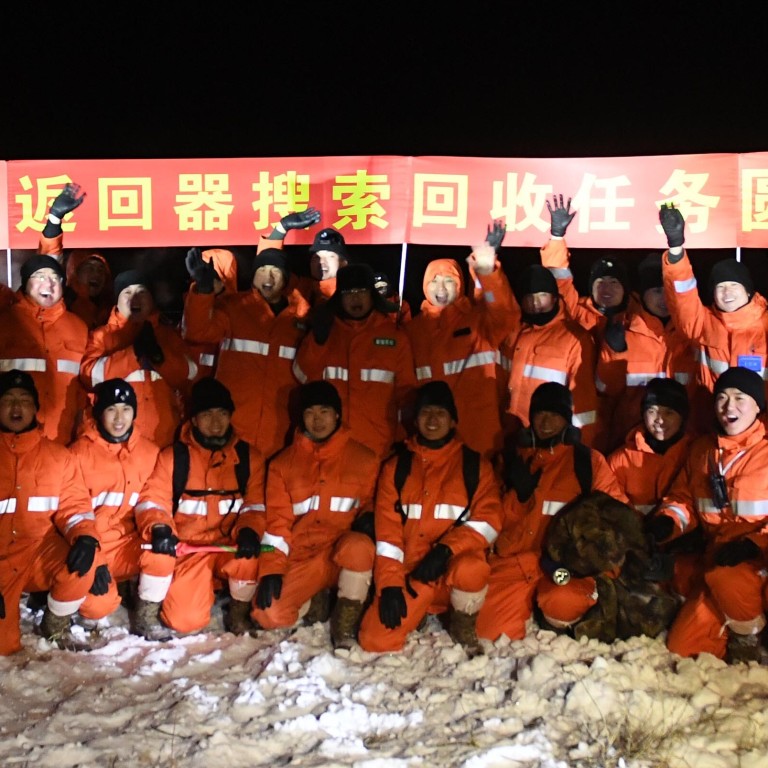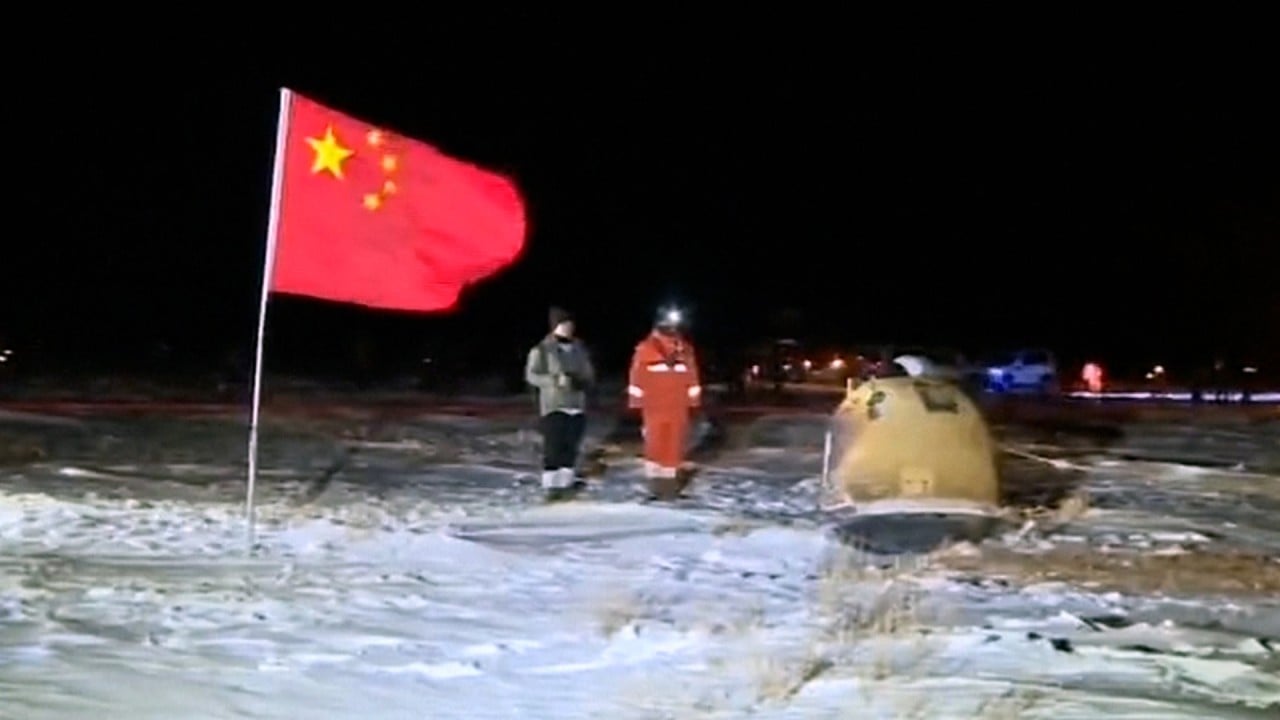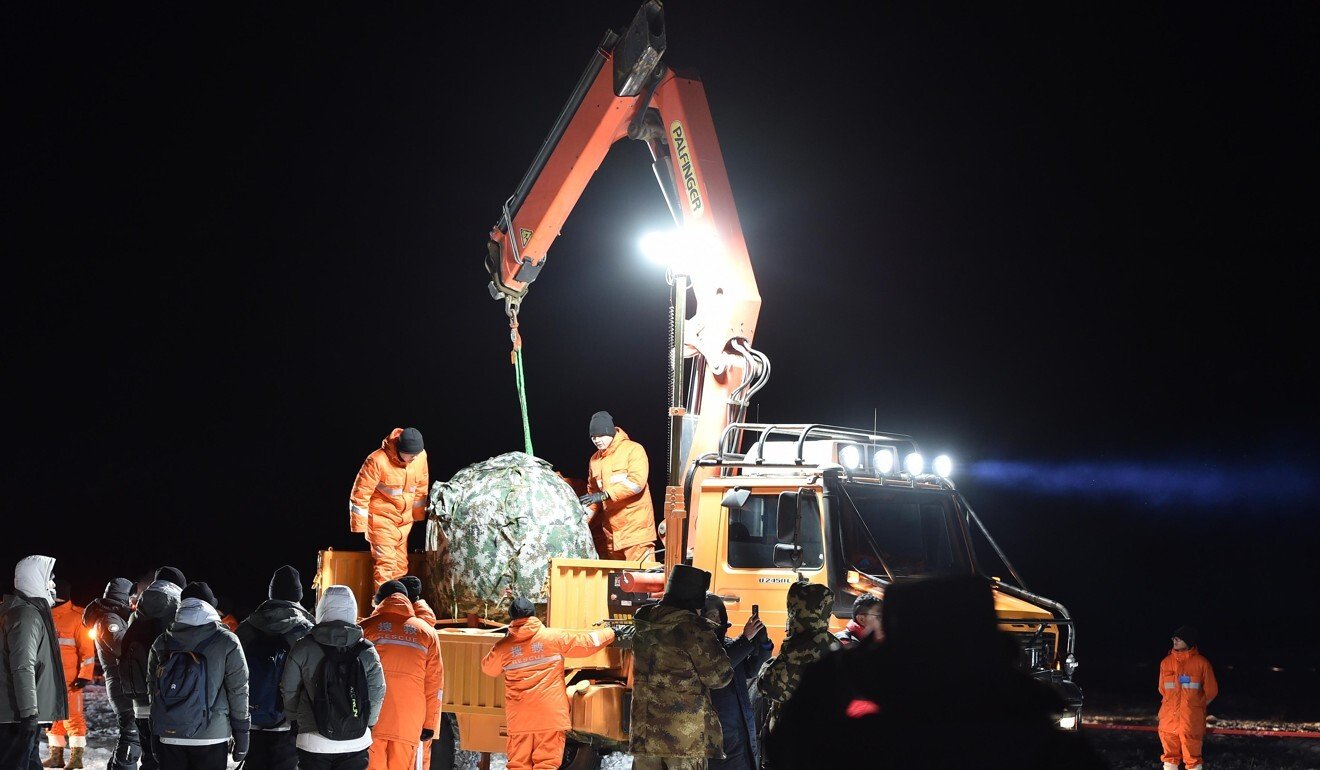
Chang’e 5 moon mission gives China ‘unequalled record’ in lunar landings
- Apollo 11 expert and space historian praises three out of three successes after raising a Tsingtao to returning capsule
- For Beijing, the programme is a vindication of its political system as well as a demonstration of technological progress

01:28
China’s Chang’e 5 lunar mission returns to Earth with moon samples
On the moon, “the on-board automatic landing computer stopped the descent while it took pictures and evaluated a landing point free of boulders and craters, then it moved sideways and descended to a safe spot,” MacTaggart said.
“I was especially impressed by the high level of Chinese automation and mechanical devices, all of which worked perfectly reliably up to 400,000km (248,500 miles) from Earth, and far beyond direct human intervention.”
“China has now achieved three highly successful lunar landings out of three attempts, which is an unequalled record in this difficult space mission … Earlier moon landings by other nations suffered many failures and used much more primitive technology,” he said.
To China, the Chang’e 5 mission was not merely a demonstration of its technological progress. It has also further bolstered the Beijing leadership’s belief in its own political system – very different from the strictly-controlled former Soviet Union or the free democracies of the West.
The goal to bring back samples from the moon by 2020 was set more than 15 years ago. Earlier missions were hampered when China’s first rover developed unexpected problems, followed by a new generation heavy-lift rocket veering off course after launch.
Lights out for China’s Chang’e 5 lander as day becomes lunar night
This year’s Covid-19 pandemic threatened to bring the Chang’e 5 mission to a standstill but the Chinese space scientists and technicians met the deadline – with less than two weeks to spare.
President Xi Jinping attributed the perfectly executed moon mission to China’s new nationwide system – called xinjuguotizhi – which unites government, businesses, universities and research institutes in a large-scale collaboration similar to the Manhattan Project.
“The success of the mission is another major achievement in overcoming difficulties by giving full play to the advantages of the new nationwide system,” he said, in a message to the Chang’e 5 team on Thursday.
Xi also had a word for the international community. China would explore the moon and beyond in collaboration with the “entire human race”, he said, suggesting Beijing had little interest in a Cold War-style race in space.
When China launched its moon exploration programme – named after the Chinese lunar goddess Chang’e – in late 2004, its plan to retrieve samples by 2020 was modest compared to the ambitious goals set by other countries at the time.
Nasa’s Constellation Programme, launched by former US president George W. Bush in 2005, promised to put astronauts back on the moon and start building a lunar base by 2020. Japan aimed to bring samples back in the same year. Even India, with no experience of human space flight, said it would land astronauts on the moon by 2020.
The Constellation project died. Design and construction of its launch vehicle, the Space Launch System – a new generation of super heavy rocket – suffered repeated delays. There were long debates in the US Congress on its escalating budget. The Obama administration, which had a greater interest in Mars, scrapped the entire project.
Other countries also failed to meet their goals. Japan’s moon exploration activities ceased after 2007 due to budget cuts. India’s first lander crashed last year, with the government only confirming the failure several months later. Attempts by other countries, such as Israel, also failed in their objectives.

And China is still, by definition, a developing country. Ouyang Ziyuan, chief scientist of the lunar programme, complained that the budget was so tight there was less money for the first mission than the construction cost of 2km (1.2 miles) of subway in Beijing.
The relatively short distance between Earth and the moon gives spacecraft little time to correct mistakes during flight. And the moon’s considerable gravity means rocket engines need to be very powerful and extremely precise, at the same time.
China dodges speeding space junk bullet after Chang’e 5 moon mission
New technology like artificial intelligence could help, but these untested approaches could equally lead to a higher chance of failure. The experts agreed that building spacecraft and rockets that were not only reliable but also smart posed a formidable challenge to a nation’s overall capabilities in science and technology.
China’s lunar mission involved a large number of companies, universities and research institutes across the country, including Hong Kong, each responsible for solving a particular issue. The division of labour and nationwide collaboration helped meet the deadline and keep the budget under control. But it also put enormous pressure on individuals.
“The pay is definitely not attractive. And there is no compensation for [working] overtime. Some of my colleagues who cannot withstand the pressure have left for the private sector,” said an engineering scientist with the state-owned China Aerospace Science and Technology Corporation (CASTC) in Beijing.
There is also growing concern within China’s space community about whether they will be able to compete with emerging private companies in the West, such as SpaceX and Blue Origin, according to some scientists.
US general describes ‘China threat’ as space race rivalry heats up
“I hope this will also happen in China one day,” the scientist said.
But Wu Yansheng, president of CASTC, lead contractor of China’s space projects, made clear it would not happen.
“Success is the fundamental driving force behind the development of China’s space programme,” he said in an official statement on Thursday morning. He urged everyone in the space sector to “remain sober, don’t let arrogance or contempt get into the head”.
China’s lunar probe sends first photo of far side of moon after historic landing
An obsession with success did not mean China would not try risky technology or aim to lead the world in space exploration, Wu said, and special funds and projects would be set aside for these efforts. But for each and every mission, “success is the last word”.
The exact nature of the lunar samples and their precise weight – the mission was aiming for 2kg of rocks and soil – will remain a mystery until the cargo reaches a military-guarded laboratory in Beijing for further examination.
The samples are a national treasure and will be divided equally between Beijing and Hunan province, birthplace of Chairman Mao Zedong. In addition to honouring Mao, the move is an extra precaution against theft, natural disaster or other threats, according to Chinese space authorities.
China’s presence in space is growing fast. By 2030, the country plans to have an international research station up and running on the moon but its space programme also has a packed calendar for the early part of 2021.

